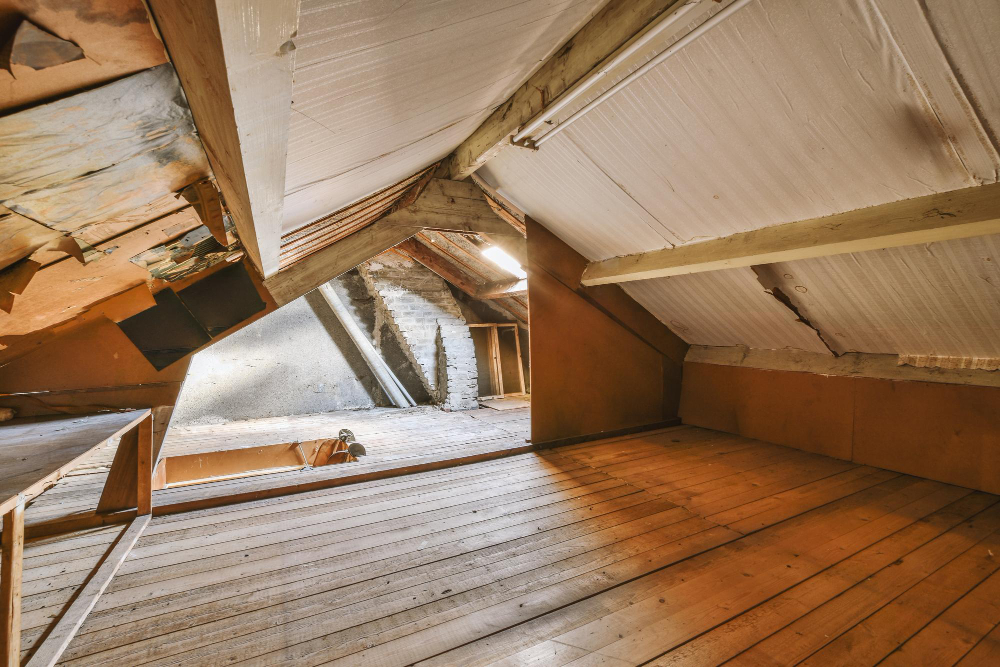Suddenly, you’ve gone up the loft and realised mould and condensation have taken over your lovely loft space. What do you do? Read our guide below on how you can help condensation disappear from your loft through various simple steps such as installing roof tile vents or simply removing clogged up boxes. These tips will allow for better air circulation within your roof space and will stop condensation when you need it most.
Here is more on loft vents and condensation and how you can help prevent from the excess condensation and moisture building up on loft surfaces by allowing for more air flow.
What is Condensation build up?
Scientifically speaking, the process of condensation is the transformation of a gaseous state into a liquid form, reversing the process of vaporisation. Condensation typically refers to condensation forming the water cycle. In addition, condensation occurs when water vapour contacts cold surfaces on a liquid or solid surface or cloud condensation nuclei occur within the atmosphere.
Building condensation and poor ventilation of moist air, or excess moisture, however, can cause a wide range of problems, including dampness, corrosion, mould, and rotting. This issue can be resolved by lowering the indoor air humidity or improving energy efficiency of the air ventilation in the building. You can achieve this in several ways:
- Opening windows
- Turning on extractor fans
- Using dehumidifiers
- Drying clothes outside
- Covering pots and pans while cooking
In addition, to aid in the removal of excessive moisture, from the humid air and move it throughout a building, air conditioning central heating and ventilation systems can help.
Getting Access to the Loft
Lofts can be challenging to get access to for various reasons, including unworkable loft ladders, poorly spaced items, and lack of entrance space. However, there are a few ways to combat this common problem.
Firstly, you’ll want to make sure that the entrance to your loft is clear; this will make your attic space a safer environment to work in and adapt to changes. Then, after you’ve cleared the space, you need to have a way of getting up into the loft. Generally speaking, this is done through a well-installed loft ladder. You’ll want your loft ladders to have a solid design and twin handrails for secure climbing. Also, make sure they are secure when being used and can hold your weight with ease, as you don’t want to risk injury.
Suppose you need help getting up in the loft due to physical limitations or safety concerns. In that case, you can always call a professional in the trades and DIY or ask a family member or friend to help, ensuring you are safe getting up and down the loft.
Inspect Your Loft
Before adding to your loft or attic, make sure you carefully inspect proper insulation for signs of mould and any condensation in loft above. You’ll also want to inspect the space for moist air inside the rafter bays to find out if vents are a potential solution for the problem and if your loft is in good standing and doesn’t require professional expertise.
As an additional measure, we’d also look for vermin droppings, as those can be common during the winter. If you find them, you can call out a vermin pest control expert or set up vermin pest traps. This overtime will help eliminate any pest droppings, bad smells, or other negative causes on your home.
Working in Your Loft
Before you proceed with any work, you must ensure you are safe when working within the loft. Lofts tend to contain loose fibres from condensation in humid air makes the loft, insulation materials and other potentially harmful materials to your skin and breathing. We’d recommend wearing long-sleeved clothes such as hoodies and jackets with long trousers. Due to dust and harmful particles, we’d recommend wearing clothes you can throw away after using them or re-using them for this sole or similar purpose in the future.
Moreover, it’s worth wearing a dust mark, some protective goggles, and knee pads for extra safety due to the dust and particles. We’d also recommend wearing durable work gloves to ensure your hands remain unscratched or open to the dangers of harmful fibres.
After you’ve finished your work in the loft, either throw away the clothes or wash them to eliminate the toxic elements attached to them, as you want to prevent any contact with the rest warm air inside of your house. We recommend when drying clothes indoors washing them separately from your other daily fabrics, as nasty elements may soak into your other materials within the wash, whether it’s done by hand or a washing machine.
Remove Boxes from the Loft Space
If your roof has vents and has issues with condensation, these may be covered up. Ventilation is available in the loft space to keep warm air cools ensure there is no moisture build-up. These vents are typically located at the eaves (lower part of the roof). If you are placing things in the other loft or roof spaces, this can disrupt airflow and render the vents useless.
Of course, space can be tough to find in a home. So we’d recommend decluttering as much as possible if this is the problem and then approaching storage boxes the solution that will fix condensation problems.
Adding Additional Roof Vents
If you’re running out of ideas, another great option that we recommend is to add additional roof vents. At ERoofing, we sell various roof vents, such as the felt lap vents that you can install easily, not requiring a professional.
However, if you choose to go for a more serious approach adequate ventilation, or get recommended to install a roof tile vent, then selecting a Klober vent or a Hambleside Danelaw vent might be a great option. From profile to plain tile vents, at ERoofing, we stock a range of vents to help your eaves ventilation needs.
Replacing Roofing Felt
If the roofing felt isn’t breathable, you can hire a roofer and have it removed and replaced with one. This process will involve removing all the cold roof slates and tiles, replacing the felt and retiling cold roof tiles, so a scaffold will be required. While this is a possible option for most roofs, this is unlikely for most households as a simply vent will help do the job.
Things to Avoid
There are many false theories on how to solve the condensation issue in a loft. To help prevent you from making mistakes, we have made a list of some common attempts that won’t help you.
One of the mistakes is adding extra layers of loft insulation. This option can cause even worse issues in your loft, so we’d highly recommend not putting insulation to fix the problem of condensation as it will be costly and non-effective if done incorrectly as foam insulation boards can rack up quickly in price.
Moreover, as mentioned above, you should attempt to minimise any storage in the loft, as it’s not a space that should be used for any or much storage due to them disrupting the airflow and causing the initial condensation problem from the get-go. Allowing the already damp air and cold air to leave your loft will aid the natural air circulation and prevent condensation process.
Removing broken roof tiles and excess insulation could be a solution; however, we recommend speaking to a qualified roofer about this solution. Making your home warmer whilst colder air in is essential, but if it causes airflow disruption, it won’t be worth it with the problems it will cause to your home and health.
Is it normal to get condensation in loft?
Condensation in lofts is a problem in a lot of homes particularly when winter arrives. This happens when warm air reaches the occupied surface and reaches the cooler lofts and causes condensation and building up of moisture. Luckily, roof vents and adequate ventilation will help condensation leave your loft space.
How do you dry out a damp loft?
There are several ways to keep the airflow adequate withing your loft space. Primarily, by utilising roof vents across your pitched roof to ensure air can flow. Secondly but just as important by ensuring any clutter is gone from the attic. You can also use things like a dehumidifier. However, this is not sustainable for long periods of time.






